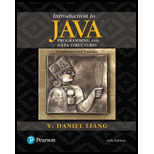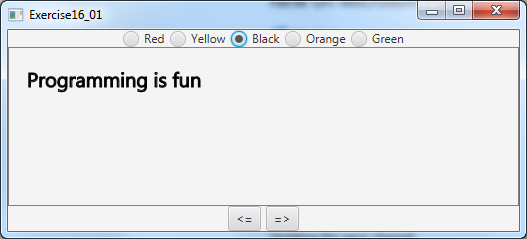
Program Plan:
- Include the required import statement.
- Define the main class.
- Declare the necessary variables
- Using start initialize the required.
- Create the border pane, radio button, text field, toggle group and button.
- Set everything into the panel.
- Add the actions event to the button.
- Create a scene and place the pane in the stage.
- Set the title.
- Place the scene in the stage.
- Display the stage.
- Define the main method using public static main.
- Initialize the call.
The below program will display the statement in different colors and move the statement left and right using GUI as follows:
Explanation of Solution
Program:
//import statement
import javafx.application.Application;
import javafx.geometry.Pos;
import javafx.scene.Scene;
import javafx.scene.control.Button;
import javafx.scene.control.RadioButton;
import javafx.scene.control.ToggleGroup;
import javafx.scene.layout.BorderPane;
import javafx.scene.layout.HBox;
import javafx.scene.layout.Pane;
import javafx.scene.paint.Color;
import javafx.scene.text.Font;
import javafx.scene.text.Text;
import javafx.stage.Stage;
//definition of "Test" class
public class Test extends Application
{
//declare the required variables
private double pane_width = 500;
private double pane_height = 150;
@Override
/*start method gets overridden in the application class*/
public void start(Stage pri_stage)
{
//create a text
Text t = new Text(20, 40, "
//set the font
t.setFont(new Font("Times", 20));
//create a text
Pane p = new Pane();
//create a label
p.getChildren().add(t);
//set the style
p.setStyle("-fx-border-color: gray");
//create a radio buttons
RadioButton r_red = new RadioButton("Red");
RadioButton r_yellow = new RadioButton("Yellow");
RadioButton r_black = new RadioButton("Black");
RadioButton r_orange = new RadioButton("Orange");
RadioButton r_green = new RadioButton("Green");
//create a toggle group
ToggleGroup group = new ToggleGroup();
//set the toggle groups
r_red.setToggleGroup(group);
r_yellow.setToggleGroup(group);
r_black.setToggleGroup(group);
r_black.setSelected(true);
r_orange.setToggleGroup(group);
r_green.setToggleGroup(group);
//create a box
HBox h_box = new HBox(5);
//create a label
h_box.getChildren().addAll(r_red, r_yellow, r_black, r_orange, r_green);
//set the alignment
h_box.setAlignment(Pos.CENTER);
//create a button
Button bt_left = new Button("<=");
Button bt_right = new Button("=>");
//create a box for button
HBox h_boxForButtons = new HBox(5);
//create a label
h_boxForButtons.getChildren().addAll(bt_left, bt_right);
//set the alignment
h_boxForButtons.setAlignment(Pos.CENTER);
//create a border pane
BorderPane border_pane = new BorderPane();
//set the border pane
border_pane.setTop(h_box);
border_pane.setCenter(p);
border_pane.setBottom(h_boxForButtons);
// create a scene and place it in the stage
Scene scene = new Scene(border_pane, pane_width, pane_height + 40);
//set the stage title
pri_stage.setTitle("Exercise16_01");
//place the scene in the stage
pri_stage.setScene(scene);
//display the stage
pri_stage.show();
// action event for the buttons gets created
r_red.setOnAction(e->t.setStroke(Color.RED));
r_yellow.setOnAction(e->t.setStroke(Color.YELLOW));
r_black.setOnAction(e->t.setStroke(Color.BLACK));
r_orange.setOnAction(e->t.setStroke(Color.ORANGE));
r_green.setOnAction(e->t.setStroke(Color.GREEN));
bt_left.setOnAction(e->t.setX(t.getX() - 1));
bt_right.setOnAction(e->t.setX(t.getX() + 1));
}
//definition of main method
public static void main(String[] args)
{
//initilaize calls
launch(args);
}
}

Want to see more full solutions like this?
Chapter 16 Solutions
Introduction to Java Programming and Data Structures, Comprehensive Version Plus MyProgrammingLab with Pearson EText -- Access Card Package
- Whentheuserenters!!,themostrecentcommandinthehistoryisexecuted.In the example above, if the user entered the command: Osh> !! The ‘ls -l’ command should be executed and echoed on user’s screen. The command should also be placed in the history buffer as the next command. Whentheuserentersasingle!followedbyanintegerN,theNthcommandin the history is executed. In the example above, if the user entered the command: Osh> ! 3 The ‘ps’ command should be executed and echoed on the user’s screen. The command should also be placed in the history buffer as the next command. Error handling: The program should also manage basic error handling. For example, if there are no commands in the history, entering !! should result in a message “No commands in history.” Also, if there is no command corresponding to the number entered with the single !, the program should output "No such command in history."arrow_forwardActivity No. Activity Time (weeks) Immediate Predecessors 1 Requirements collection 3 2 Requirements structuring 4 1 3 Process analysis 3 2 4 Data analysis 3 2 5 Logical design 50 3,4 6 Physical design 5 5 7 Implementation 6 6 c. Using the information from part b, prepare a network diagram. Identify the critical path.arrow_forward2. UNIX Shell and History Feature [20 points] This question consists of designing a C program to serve as a shell interface that accepts user commands and then executes each command in a separate process. A shell interface gives the user a prompt, after which the next command is entered. The example below illustrates the prompt osh> and the user's next command: cat prog.c. The UNIX/Linux cat command displays the contents of the file prog.c on the terminal using the UNIX/Linux cat command and your program needs to do the same. osh> cat prog.c The above can be achieved by running your shell interface as a parent process. Every time a command is entered, you create a child process by using fork(), which then executes the user's command using one of the system calls in the exec() family (as described in Chapter 3). A C program that provides the general operations of a command-line shell can be seen below. #include #include #define MAX LINE 80 /* The maximum length command */ { int…arrow_forward
- Question#2: Design and implement a Java program using Abstract Factory and Singleton design patterns. The program displays date and time in one of the following two formats: Format 1: Date: MM/DD/YYYY Time: HH:MM:SS Format 2: Date: DD-MM-YYYY Time: SS,MM,HH The following is how the program works. In the beginning, the program asks the user what display format that she wants. Then the program continuously asks the user to give one of the following commands, and performs the corresponding task. Note that the program gets the current date and time from the system clock (use the appropriate Java date and time operations for this). 'd' display current date 't': display current time 'q': quit the program. • In the program, there should be 2 product hierarchies: "DateObject” and “TimeObject”. Each hierarchy should have format and format2 described above. • Implement the factories as singletons. • Run your code and attach screenshots of the results. • Draw a UML class diagram for the program.arrow_forward#include <linux/module.h> #include <linux/kernel.h> // part 2 #include <linux/sched.h> // part 2 extra #include <linux/hash.h> #include <linux/gcd.h> #include <asm/param.h> #include <linux/jiffies.h> void print_init_PCB(void) { printk(KERN_INFO "init_task pid:%d\n", init_task.pid); printk(KERN_INFO "init_task state:%lu\n", init_task.state); printk(KERN_INFO "init_task flags:%d\n", init_task.flags); printk(KERN_INFO "init_task runtime priority:%d\n", init_task.rt_priority); printk(KERN_INFO "init_task process policy:%d\n", init_task.policy); printk(KERN_INFO "init_task task group id:%d\n", init_task.tgid); } /* This function is called when the module is loaded. */ int simple_init(void) { printk(KERN_INFO "Loading Module\n"); print_init_PCB(); printk(KERN_INFO "Golden Ration Prime = %lu\n", GOLDEN_RATIO_PRIME); printk(KERN_INFO "HZ = %d\n", HZ); printk(KERN_INFO "enter jiffies = %lu\n", jiffies); return 0; } /* This function is called when the…arrow_forwardList at least five Operating Systems you know. What is the difference between the kernel mode and the user mode for the Linux? What is the system-call? Give an example of API in OS that use the system-call. What is cache? Why the CPU has cache? What is the difference between the Static Linking and Dynamic Linking when compiling the code.arrow_forward
- In the GoF book, List interface is defined as follows: interface List { int count(); //return the current number of elements in the list Object get(int index); //return the object at the index in the list Object first(); //return the first object in the list Object last(); //return the last object in the list boolean include(Object obj); //return true is the object in the list void append(Object obj); //append the object to the end of the list void prepend(Object obj); //insert the object to the front of the list void delete(Object obj); //remove the object from the list void deleteLast(); //remove the last element of the list void deleteFirst(); //remove the first element of the list void deleteAll(); //remove all elements of the list (a) Write a class adapter to adapt Java ArrayList to GoF List interface. (b) Write a main program to test your adapters through List interface. (c) Same requirement as (a) and (b), but write an object adapter to adapt Java ArrayList to GoF List…arrow_forwardIn modern packet-switched networks, including the Internet, the source host segments long, application-layer messages (for example, an image or a music file) into smaller packets and sends the packets into the network. The receiver then reassembles the packets back into the original message. We refer to this process as message segmentation. Figure 1.27 (attached) illustrates the end-to-end transport of a message with and without message segmentation. Consider a message that is 106 bits long that is to be sent from source to destination in Figure 1.27. Suppose each link in the figure is 5 Mbps. Ignore propagation, queuing, and processing delays. a. Consider sending the message from source to destination without message segmentation. How long does it take to move the message from the source host to the first packet switch? Keeping in mind that each switch uses store-and-forward packet switching, what is the total time to move the message from source host to destination host? b. Now…arrow_forwardConsider a packet of length L that begins at end system A and travels over three links to a destination end system. These three links are connected by two packet switches. Let di, si, and Ri denote the length, propagation speed, and the transmission rate of link i, for i = 1, 2, 3. The packet switch delays each packet by dproc. Assuming no queuing delays, in terms of di, si, Ri, (i = 1, 2, 3), and L, what is the total end-to-end delay for the packet? Suppose now the packet is 1,500 bytes, the propagation speed on all three links is 2.5 * 10^8 m/s, the transmission rates of all three links are 2.5 Mbps, the packet switch processing delay is 3 msec, the length of the first link is 5,000 km, the length of the second link is 4,000 km, and the length of the last link is 1,000 km. For these values, what is the end-to-end delay?arrow_forward
- how to know the weight to data and data to weight also weight by infomraion gain in rapid miner , between this flow diagram retrieve then selecte attrbuite then set role and split data and decision tree and apply model and peformance ,please show how the operators should be connected:arrow_forwardusing rapid miner how to creat decison trea for all attribute and another one with delete one or more of them also how i know the weight of each attribute and what that mean in impact the resultarrow_forwardQ.1. Architecture performance [10 marks] Answer A certain microprocessor requires either 2, 4, or 6 machine cycles to perform various operations. ⚫ (40+g+f)% require 2 machine cycles, ⚫ (30-g) % require 4 machine cycles, and ⚫ (30-f)% require 6 machine cycles. (a) What is the average number of machine cycles per instruction for this microprocessor? Answer (b) What is the clock rate (machine cycles per second) required for this microprocessor to be a "1000 MIPS" processor? Answer (c) Suppose that 35% of the instructions require retrieving an operand from memory which needs an extra 8 machine cycles. What is the average number of machine cycles per instruction, including the instructions that fetch operands from memory?arrow_forward
 New Perspectives on HTML5, CSS3, and JavaScriptComputer ScienceISBN:9781305503922Author:Patrick M. CareyPublisher:Cengage Learning
New Perspectives on HTML5, CSS3, and JavaScriptComputer ScienceISBN:9781305503922Author:Patrick M. CareyPublisher:Cengage Learning C++ for Engineers and ScientistsComputer ScienceISBN:9781133187844Author:Bronson, Gary J.Publisher:Course Technology Ptr
C++ for Engineers and ScientistsComputer ScienceISBN:9781133187844Author:Bronson, Gary J.Publisher:Course Technology Ptr EBK JAVA PROGRAMMINGComputer ScienceISBN:9781337671385Author:FARRELLPublisher:CENGAGE LEARNING - CONSIGNMENT
EBK JAVA PROGRAMMINGComputer ScienceISBN:9781337671385Author:FARRELLPublisher:CENGAGE LEARNING - CONSIGNMENT Microsoft Visual C#Computer ScienceISBN:9781337102100Author:Joyce, Farrell.Publisher:Cengage Learning,
Microsoft Visual C#Computer ScienceISBN:9781337102100Author:Joyce, Farrell.Publisher:Cengage Learning, EBK JAVA PROGRAMMINGComputer ScienceISBN:9781305480537Author:FARRELLPublisher:CENGAGE LEARNING - CONSIGNMENT
EBK JAVA PROGRAMMINGComputer ScienceISBN:9781305480537Author:FARRELLPublisher:CENGAGE LEARNING - CONSIGNMENT





